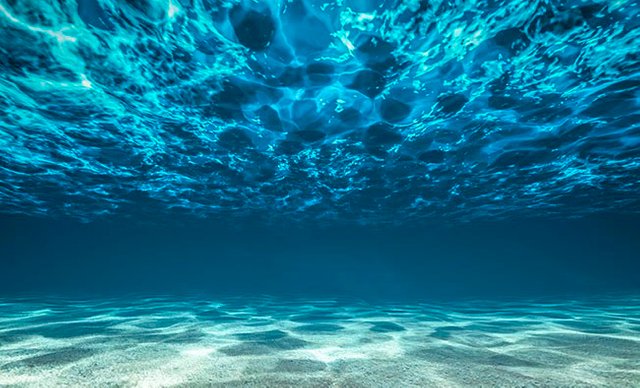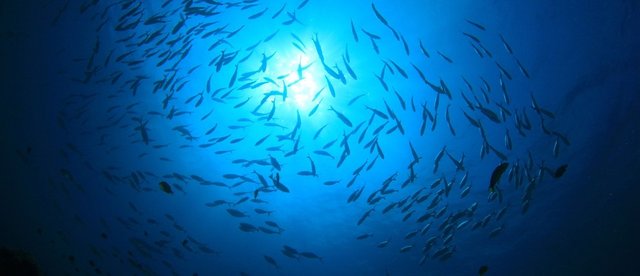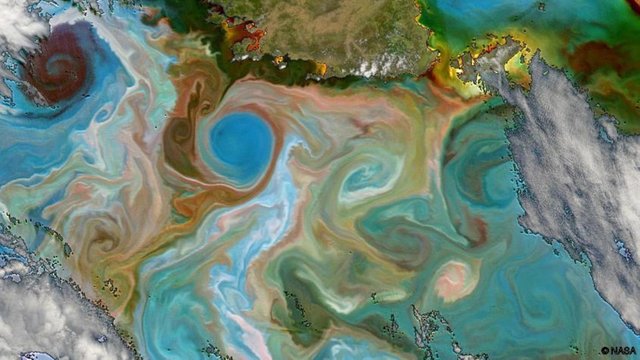SCIENTIFIC EXPLANATION ABOUT THE OCEAN'S COLOR
Introduction

Image Source
Situated below the horizon lies the vast waters of the ocean deeps. But have you really ever wondered and came to think what really is the real color if the ocean? Is it its natural beauty that makes it blue? Something green at times? or perhaps something it could reflect from?
Image Source
If someone were to ask you what is the color of the ocean, chances are that you would answer that is was blue. For most of the world's oceans, your answer would be correct. Pure water is perfectly clear, of course -- but if there is a lot of water, and the water is very deep so that there are no reflections off the sea floor, the water appears as a very dark navy blue
This blog offers you an insight about why is the ocean really blue, what causes it and how does it happen; why sometimes its different color other than blue.
IS IT BECAUSE OF THE SKY'S REFLECTION THAT MAKES THE OCEAN BLUE?

Image Source
The ocean looks blue because red, orange and yellow (long wavelength light) are absorbed more strongly by water than is blue (short wavelength light). So when white light from the sun enters the ocean, it is mostly the blue that gets returned. Same reason the sky is blue.
In other words, the color of the ocean and the color of the sky are related but occur independently of each other: in both cases, the preferential absorption of long-wavelength (reddish) light gives rise to the blue. Note that this effect only works if the water is very pure; if the water is full of mud, algae or other impurities, the light scattered off these impurities will overwhelm the water's natural blueness.
Gross then asks, "So why are sunsets orange?" Several people to wrote in to correct or clarify that comment.
Perhaps the most helpful response came from Michael Kruger of the Department of Physics at the University of Missouri. He sent the following reaction:
"The answer to why the sky is blue isn't quite correct. The sky is blue not because the atmosphere absorbs the other colors, but because the atmosphere tends to scatter shorter wavelength (blue) light to a greater extent than longer wavelength (red) light. Blue light from the sun is scattered every which way, much more so than the other colors, so when you look up at the daytime sky you see blue no matter where you look. This scattering is called 'Rayleigh scattering'; the amount of scattering goes as the frequency of the light to the 4th power. By the way, this effect is most prevalent when the particles that do the scattering are smaller than the wavelength of light, as is the case for the nitrogen and oxygen molecules in the atmosphere."
The Physics Behind
Pure water is of course clear. However if it is deep enough, so that light cannot reflect off the sea floor, it appears dark blue. This is largely because of some basic physics.
Human eyes contain cells capable of detecting electromagnetic radiation with wavelengths between around 380-700 nanometres. Within this band, different wavelengths correspond to the different colours we see in a rainbow.
Water molecules are better at absorbing light that arrives in longer wavelengths, meaning the reds, oranges, yellows and greens. This mostly leaves the blues, which have shorter wavelengths. As blue light is less likely to be absorbed, it can penetrate to deeper depths, making deep water look bluer.

Image Source
Light at a short wavelength is also more likely to be scattered or deflected in different directions, including back out of the water towards our eyes, making the sea appear blue.
However, the purity of sea water varies. Particles suspended within it can increase the scattering of light. Sand and silt carried into the sea from rivers, or kicked up from the seafloor by waves and storms, can affect the colours of coastal waters. And organic detritus such as decayed plant matter - known to scientists as colour dissolved organic matter - can also complicate the picture, by adding greens, yellows or browns.
"Phytoplankton absorb electromagnetic radiation in the red and blue parts of the visible light spectrum."

Image Source
That's the physics. But even more important is the biology, because the biggest impact on sea colour is made by tiny organisms called phytoplankton.
Usually smaller than a pinhead, these single-celled algae use green chlorophyll pigments to capture energy from the sun to convert water and carbon dioxide into the organic compounds that make up their bodies. Through this photosynthesis, they are estimated to be responsible for generating about half of the oxygen we breathe.
Crucially, phytoplankton absorb electromagnetic radiation in the red and blue parts of the visible light spectrum, but reflect greens, which explains why seas in which they are thriving appear greener.
References
- http://www.bbc.com/earth/story/201505226-is-the-sea-really-blue
- https://www.scientificamerican.com/article/why-does-the-ocean-appear/
- https://science.nasa.gov/earth-science/oceanography/living-ocean/ocean-color

good content
What part did you like the most?
you copied large passages of text from your source, which is called "plagiarized".
Oh snap
Good day @sco. I did yes! And I am really amenable about that that's why I quoted so many references. That doesn't mean I copy large passages that's already plagiarism on my behalf but that's just being resourceful in my references. Nevertheless, I am giving credits to the references which I got my post composed from.
if you copy something from a source that you cite, you have to indicate that it's a quote.
"...or like this"
If you fail to do so, you make your readers believe the text was written by yourself, exactly.
Thank you so much @sco. I so appreciated your tip. Despite the fact that I made a mess on this post, Im still grateful to the people like you who notice someone's works. Thanks and will refrain from committing that mistake again. God bless and more power to the Steemit Community!